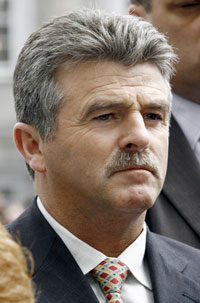27 September 2007 Edition
British Government running out of options on nuclear waste

Arthur Morgan
BY ROBBIE SMYTHBRITAIN’S National Academy of Science, the Royal Society, has produced a damning report on Sellafield’s growing plutonium stockpiles and its failure to plan for their safe storage, Sellafield Ltd has embarked on PR exercise by holding a VIP reception to watch the demolition of the four Calder Hall cooling towers on the 4km site.
The demolition of the Calder Hall towers has been cleared by the Nuclear Installations Inspectorate. The towers are part of Britain’s first commercial nuclear power station, which began operations in 1956 and ceased producing electricity in 2003. The entire Calder Hall site has 62 buildings and four nuclear reactors. The demolition of the cooling towers is, in fact, a very small part of the total decommissioning process.
While Sellafield has been hyping up the Calder Hall demolition with a breakfast buffet, there was no wine reception to mark the publication of the Royal Academy’s report last week into the 103 tonnes of plutonium stored around the Sellafield facility. The 103 tonnes is enough to make more that 17,000 nuclear bombs. The radioactive stockpile has doubled in size over the last ten years.
It was nine years ago that the Academy warned the newly-elected New Labour British Government that the plutonium hoard was being kept in unacceptable conditions. Since then, nothing has been done and it will be 2075 before the Nuclear Decommissioning Authority has a suitable repository to store such material, even though they don’t know where or how the waste will be stored.
The Nuclear Decommissioning Authority has responsibility for 20 nuclear sites that were previously owned by either British Nuclear Fuels, (now called the British Nuclear Group) or the Atomic Energy Authority.
Right now in Britain there are 10 working nuclear power stations with 19 reactors that provide approximately 18% of British electricity and the operations of these plants will add substantially to the plutonium stocks already in Sellafield.
The options, according to the Academy report, are for either reprocessing in the Thorp nuclear reprocessing plant (which is currently shut down because of leaks at the plant and was never envisaged to operate past 2010) or turn the plutonium into what they call MOX pellets. The plant for this too is shut down, so for now the waste stays where it is.
In 2003, a security review at Sellafield led to additional fencing, armed police patrols on the site and a plutonium separation area within the site. Some concrete barriers were also built on parts of the periphery of the site.
None of this changes the fact that there is still no strategic plan for the safe storage of the waste.
PROOF
Arthur Morgan, Sinn Féin’s Environment spokesperson and Louth TD, told An Phoblacht that he “wasn’t surprised” at the Academy report but the findings are “proof that the British Government is on one hand pushing the agenda for new nuclear power stations while failing to deal with the legacy of waste and pollution from the existing nuclear industry on the other”.
Morgan added:
“If the same effort and resources was invested in developing renewable energies the electricity industry would be transformed. Instead we have the continuation of a failed strategy that endangers the environment and will ultimately cost the taxpayer tens of billions of euro to clean up a mess that could have been avoided.”
The VIP reception for the Calder Hall demolition, Morgan said, “is typical of the window dressing we know well from the British nuclear industry”.
Morgan said that, on the same site as the Calder Hall towers, there is a pool of radioactive material called B30 which has been used as an undocumented dump for 50 years and is in contravention of the EURATOM Treaty.
“I don’t expect that we will have online streaming of the operations of that toxic dump too but it is just one more example of the double standards that run through every layer of the British nuclear industry.”


